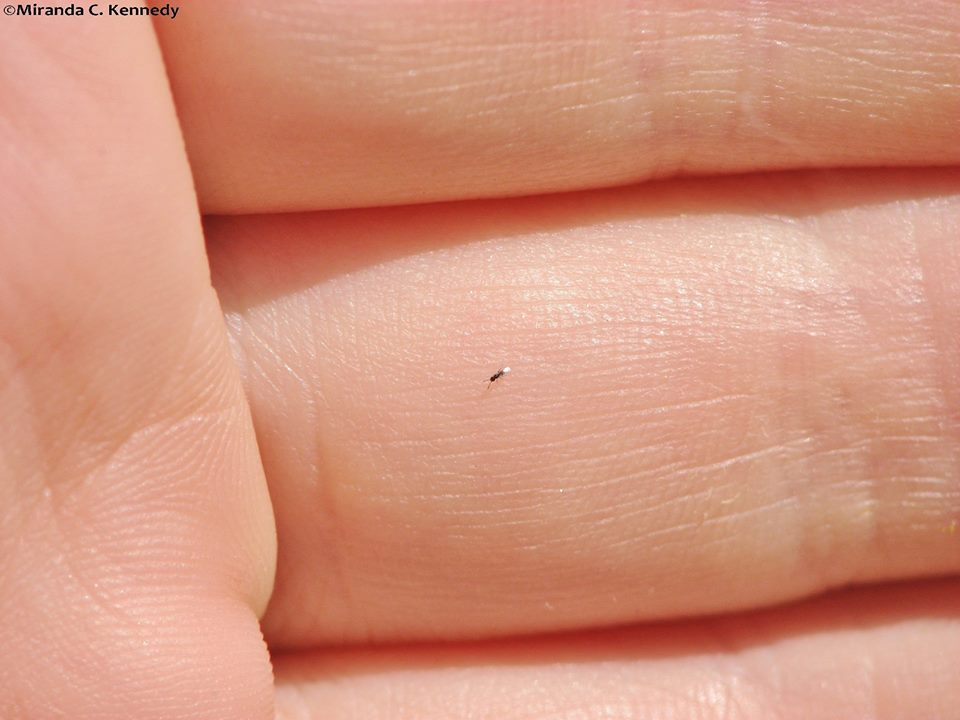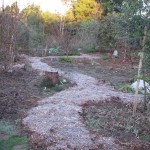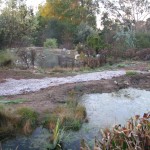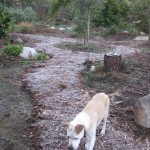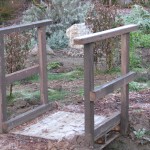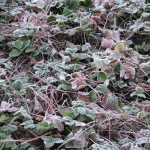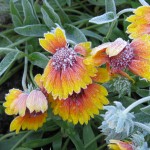-
The Fine Art of Pleaching or Plashing
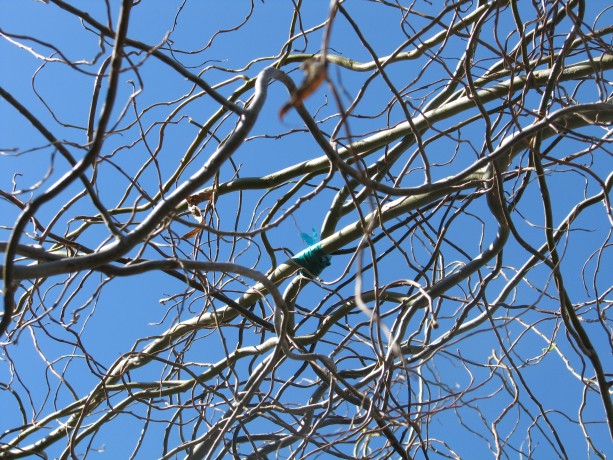
Pleaching in the sky. My daughter and I pleached today, although I’ve had the pleasure of pleaching before this , and even later. Pleaching, or its synonym plashing, refers to the interweaving of branches, both live or dead. Basketry is one form, but more notably is the pleaching of living branches to form secure living fences, buildings or artwork. The withy (willow) bird hide (a covered place from which to watch birds) is a living building I planted two years ago. We pleached our withy hide today. Not many people can say that! (or admit to it).
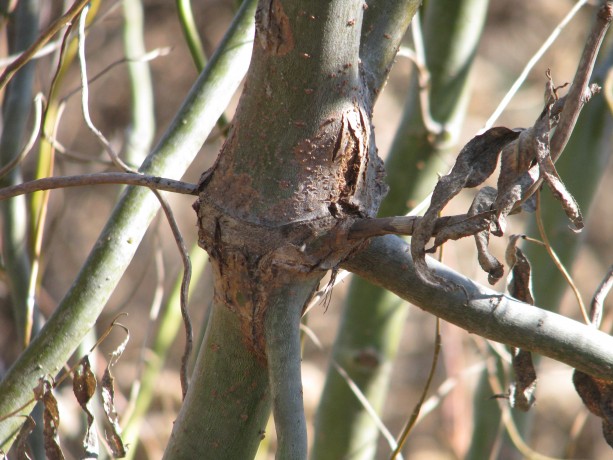
Pleaching is where stems, usually from two plants, grow together. Pleaching can be done on many vigorous trees such as willow, or even fruit trees such as plum. The branches grow together making separate plants become part of a whole. The trees then share nutrients and water and can pull what it needs from roots a long distance away.
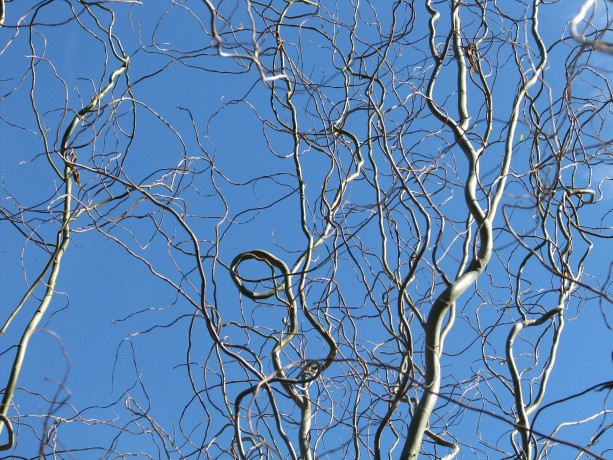
Curly willow is beautiful on its own. Pleaching essentially makes many plants into one living organism. Pleached hedgerows make a living barrier to keep in livestock; pleached trees can be woven into furniture, living artwork, decorative fences, and living trellises. Pleaching livestock fences was practiced a lot in Europe prior to the invention of barbed wire, and then was forgotten for awhile only to be revived as a form of artistic gardening.

This trunk unfortunately cracked while I pulled on it. As it is willow, it will heal quickly. My daughter used the opportunity to put a twig from the next willow through the crack, which will grow over it. Today I of course, as is my habit, waited until the sun was directly above the area where I was working so that I had to look into it as I worked. I don’t recommend this, however. My daughter used a fruit-picking pole to snag some of the taller, whippier branches of the curly willow that make up the withy hide. I stood on a ladder, squinting, and pulled two branches together.
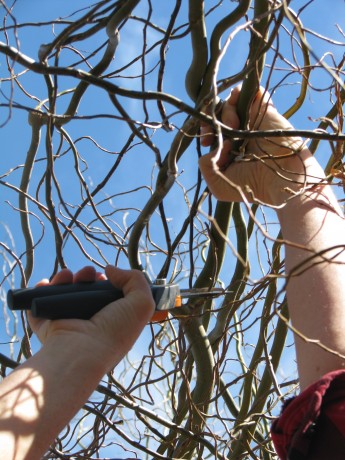
Me on a ladder reaching over my head to pull two branches together to form a roof. To insure that you have a good pleach going, it is best to lightly scrape the bark from both pieces just where they are going to meet; something like you see blood brothers do with their hands in the movies, but with no blood involved.

Lightly scraping the bark from both branches where they will meet is important. Next time I’ll use a vegetable peeler, which will allow me better angles. Then you make sure the pieces fit snugly, then tie them on. I’ve use various materials to do this. Twist-ties hold securely but the wire can eventually girdle the growing branches. Twine is more difficult to use in that it doesn’t grip the branches well enough for a firm hold, but it will eventually break down, hopefully after the pleach is successful. This time I used green tree tape. It grips well, is easy to tie, and will stretch with the growing branches and eventually break. The green color won’t be noticeable when the willow leafs out, either.
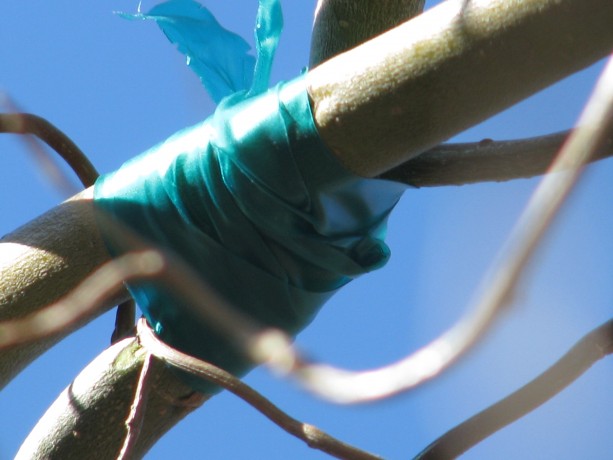
Tying the scraped branches together so they stay put. They can’t move around in the wind or they won’t be able to grow together. As I pleached from the top of the ladder, working overhead while the sun and curly twigs attacked my eyes, my daughter pleached pleasing arches over the ‘windows’ of the hide.
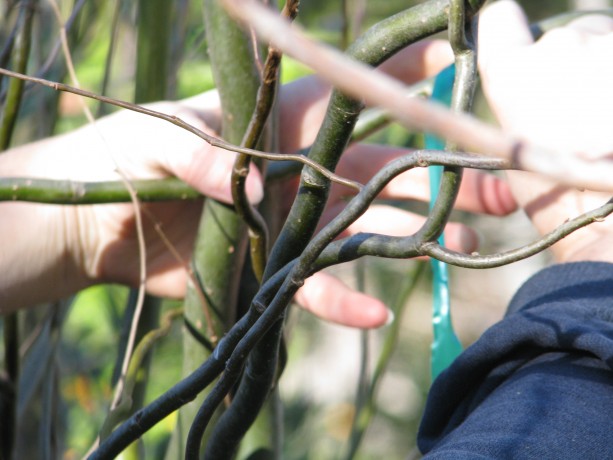
Weaving curly willow can be a twisty challenge. The hide looks lopsided because the willows on one side have found sent out roots to drink from the small pond. With more pleaching, the thirsty trees on the other side will probably take advantage of that water source, too, and have a drink via their overhead connection. I think it is part of its charm. A half-wild building.
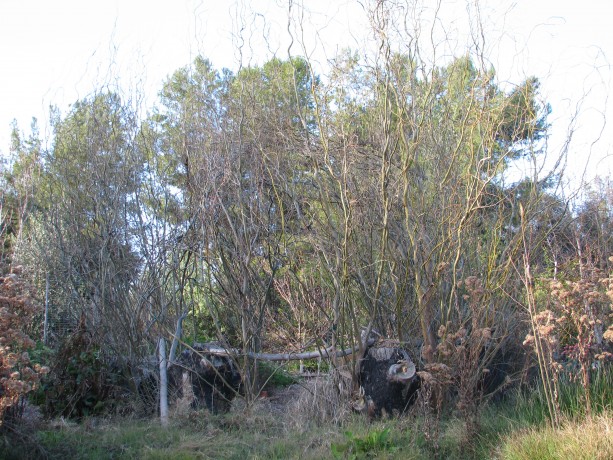
The withy hide as a duck on the big pond sees it. The willow is just about to begin leafing out. Try pleaching a small fence or a living bench or chair. It is tremendous fun and if you don’t like it, you can always cut it down. Oh, and work on a cloudy day.
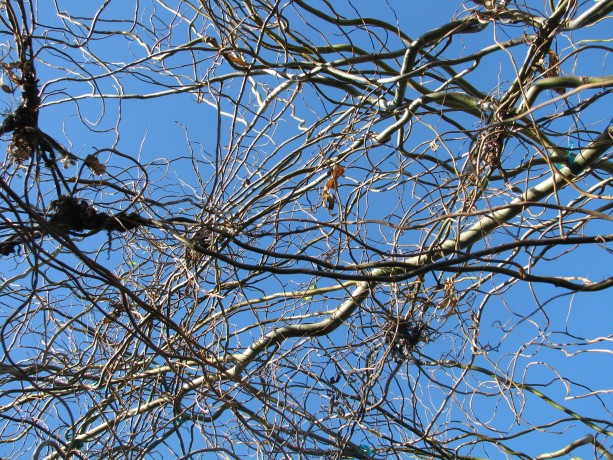
A willow roof. -
Good-bye, Sweet Belle: The Death of a Crossbill Hen

Belle in her bath. Last Tuesday when I opened the chicken tractor to let the girls come bounding and clumsily flutter out for their breakfast, Belle our genetic crossbill Americauna didn’t emerge with her usual energy. I make a custard of blended chicken food, whole eggs, greens and fruit, cooked and cooled, to feed her. The custard contained all the goodies the other hens had, but was easier for her to scoop with her twisted beak. I’d fill her dish before I come down to ‘do the hens’, and she was fed first. Her dish was placed into the top of the quail hut with the door propped open so only Belle coud get in and out; the other hens loved to share her food otherwise.
Although Belle ate vigorously, she never gained full body weight. Her beak prevented her from eating well enough. Out of every five scoop attempts at the custard I’d say that she’d get one mouthful. Yet she was always perky, always running around interested in everything, and even tried dominance tactics over some of the other girls. They’d let her since she wasn’t a threat to any of their food.
Because Belle’s eating habits were very messy her neck and head feathers were straggly, and combined with her twisted beak gave her a comical, slightly crazed look. Because she was handled so much when she patiently allowed us to trim her beak and nails, and give her a bath, she was very friendly. She’d jump on our backs and shoulders any time we’d bend over in the coop. She’d enjoy being carried around. She was very spoiled. We’d read posts where owners of crossbills, who didn’t cull them but kept them as pets, had them live up to ten years and lay eggs. It was all dependant upon to what degree their bills crossed, and Belle’s became severe.
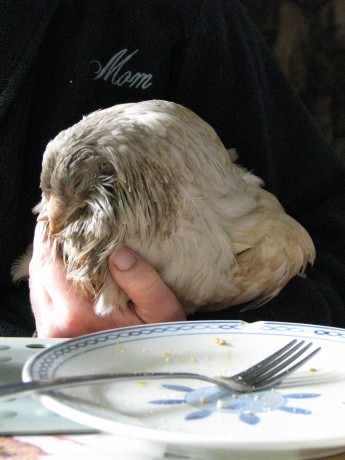
About a month ago we noticed mites on her, something that is common on hens, and gave her a good bath and treatment with food grade diotomaceous earth. The FGDE works immediately and is very effective and safe. Otherwise she was bright, fun and perky, burrowing under the other girls on the roost overnight to cuddle.
Tuesday Belle was slower to come around, and didn’t want to eat. A hungry hen not wanting to eat? Bad news. We immediately took her into the house. It was a cold day, so we made her comfortable next to a space heater. On inspection we discovered that she had mites all over her. We also checked the other hens right away and they were all okay, so apparently Belle’s diminishing health encouraged them to reproduce, and as she couldn’t groom herself she was stuck. We coated her with FGDE, not wanting to bathe her while she was feeling poorly since it was a cold day, and dropper fed her food. She showed some energy and wanted to run around, and took the food hungrily.
It was time to trim the Christmas tree, and my daughter put Belle under her sweater to keep her warm and comforted as we worked; Belle loved being cuddled and held, so she put up no resistance, but we could see that she was ill.
We brought in the cage that we used for Viola the ex-house chicken, and for all of our patients, and tucked Belle in for the night next to the space heater.
In the morning Belle was sitting very still. I knew that she was nearly gone. Just after waking my daughter, Belle died as she held her. She is buried outside our bay window where we watch birds, close to the house.
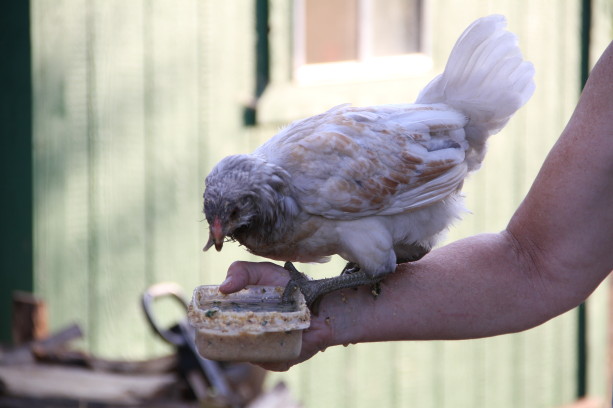
Belle usually can’t wait until she’s served. Birds are so tricky. They can seem perfectly fine, but when they show illness it is usually too late and the end comes quickly. There is little you can do for them besides keep them comfortable. Neither of us expected Belle to pass away; she showed no previous symptoms and was her usual plucky, fun self. Something internal gave way from slow malnutrition caused by that darned crossed bill and her inability to eat enough. On reflection I don’t think that Belle had a bad life. She ate enough to not be hungry all the time, and her custard gave her ease of eating. She was much loved and spoiled. Her end was quick, which was merciful and not granted to many of us. But Belle will always be remembered.

Ah haz a friend! - Animals, Bees, Birding, Gardening adventures, Heirloom Plants, Other Insects, Permaculture and Edible Forest Gardening Adventures, Quail, Seeds
Growing Birdseed: Love Lies Bleeding Amaranth
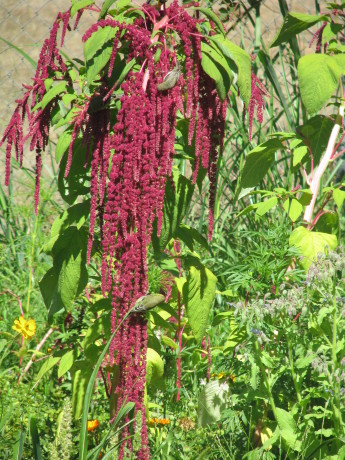
Love-Lies-Bleeding amaranth is a dramatic addition to your garden… ask a bird! We’ve participated in Cornell University’s winter Project Feederwatch for about six years. It is a volunteer amateur scientist-type program where, from November through March, you fill bird feeders and two days a week count how many birds come. Then you report your results on an online form. This helps trace changes in migration patterns and in habitats in wild birds, as well as sitings of diseased birds.
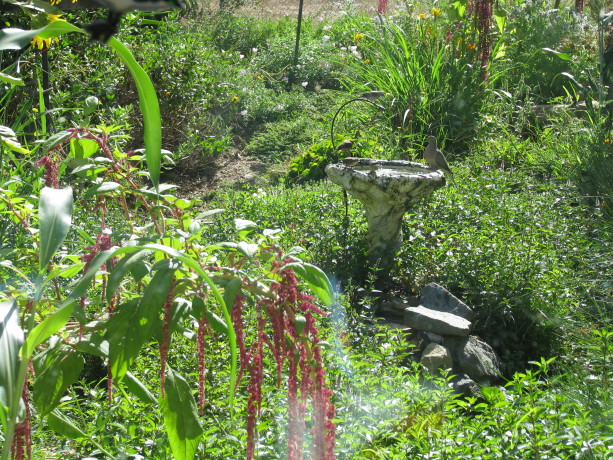
The sound of dripping water attracts birds more than food does… from long distances, too. This year I found out that most birdseed is contaminated by insecticide; some brands are reported to have illegal levels of pesticides in them. Geez! How am I going to get around that problem? I’m not sure about this winter, but I’m going to grow more of my own birdseed. In the past we’ve rolled pine cones in peanut butter and hung them out for woodpeckers and many other birds. I’ve also grown sunflowers, for both their seeds and for their leaves, which lesser goldfinches just love to eat! This year I planted heirloom Love Lies Bleeding Amaranth (Amaranthus caudatus) to some pretty spectacular results. Yes, this is one of the types of amaranth that produces an edible seed for humans; the leaves are edible as well. It can grow 3 -6 feet, with long ruby-red falls of seed heads that the birds just love.
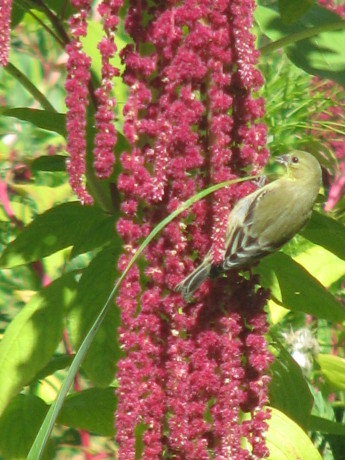
One of our Finch Frolic Finches feeding! There are many other amaranths to grow for both your own consumption as well as for the birds. Sometimes you grow it for yourself and end up feeding the birds! Of course there are many plants which attract hummingbirds all year, especially those with tubular flowers. Why do you want to attract birds? Besides their right to habitat, and their appeal to our better selves, all native animals play important roles in the preditor/prey relationship in a healthy garden. The birds may eat some of your produce, but they are also eating large amounts of bugs. They are also pooping, and you know how valuable poop is to any garden! If you plant a bird garden away from your vegetable crops, then plant your veg crops using the polyculture method, you will have birds and food for yourself as well. Please, please don’t put up those dangerous tree nets! They tear apart your trees when you try to remove them, they don’t really work, and birds can be stuck in them. When they are on the ground snakes are trapped in them! No plastic netting. Ever. Please!
Try planting some amaranth – especially this one with the dramatic name and dramatic fall of color – next spring when you plant a bird garden. Or in your edible forest garden and plant guilds. Or between your fruit trees, or along the back of your flower beds. Take a nibble for yourself if the birds will let you!
-
Why Finches Turn Red, and Other Interesting Animal Dating Facts
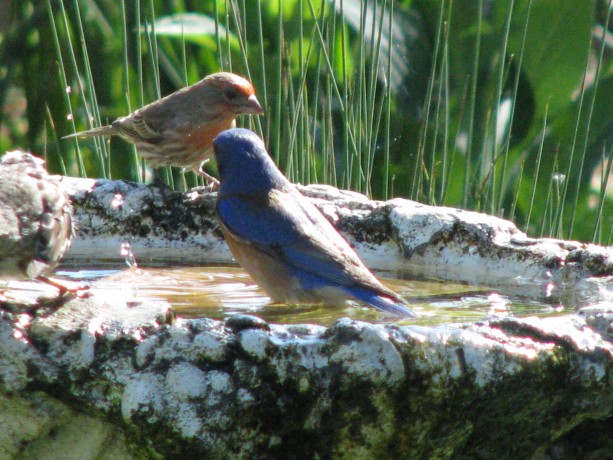
A male house finch and a male western bluebird just as mating season was kicking in. Spring is half-way through and many animals have already had their first batch of young; some are working on their second. Perhaps you noticed when some of the house finches turned a bright shade of red? In fact, many male animals look much differently than the females, becoming more brightly colored, larger, darker, or grow larger horns or antlers. This phenomena is called sexual dimorphism. This is a complicated topic when you begin to analyze all the different forms and shapes boys and girls of the animal kingdom take in order to keep their gene pool going. However I’m going to simplify it because it is pretty darn interesting.
Consider an animal; lets take a house finch. Their lives are spent finding food, finding a mate, finding lots more food for themselves and their young, and surviving predation, accidents and weather. There isn’t much time for playing around. The dawn chorus is the birds calling out that they survived another 24 hours and where is everyone else?
Consider animal calories as money. Finding food and surviving costs a lot of money/calories. For a male house finch to impress a female, they want to make sure they convey the message that they are better at finding food and more macho than the other males. This trait is essentially true for all polygamous (don’t mate for life) animals. (Let that be a lesson learned, girls!) In flocks or packs or herds that are open and often on the move, guys show their wealth through coloration, size and ornamentation. It takes more calories for the finch to turn colors, just like it takes lots of calories for peacocks to be larger and gaudier than females, or cape buffalo to be darker, or ungulates to grow really large horns. But why a brighter shade of red? The bright colors and larger size (in part) show that these males aren’t afraid of attracting the attention of predators because they are strong and macho enough to survive an attack. The darker the color, the more calories, the more fit and healthy, and thus the better food-gatherer and protector for the brood. The guys are saying, “Bring it on!”
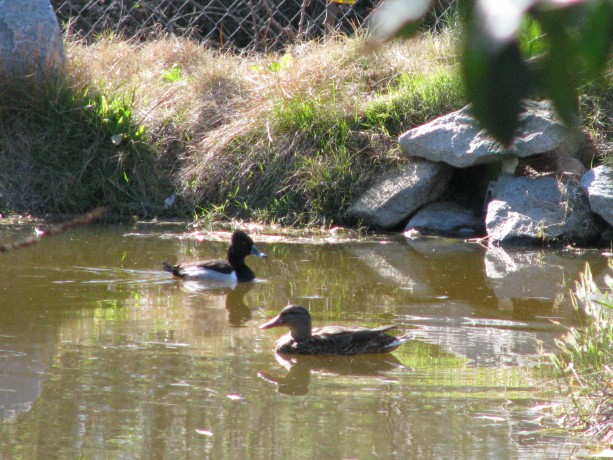
Mallard drakes are very colorful compared to the ducks. Females of these sexual dimorphic species are given a hard rap by being called dull-colored. What they are, of course, are smartly colored. They are camouflage to fit in with the area in which they will be nesting. They are thinking ahead. They don’t go in for dramatic courtship dances because they don’t have to: the guys are desperate for a healthy female to be attracted to them so that they can pass on their genes. It is a buyer’s market. Females also need to store calories because creating eggs or gestating and giving birth then feeding/producing milk and raising kids to maturity is very expensive. Isn’t it, though?
In closed herds or with animals who are monogamous (crows, for instance), the males don’t need to spend money on dates, so dressing up is just considered a waste of money/calories. (Does that sound familiar?).
As I mentioned, there are many variations on the whole sex thing, such as species where the females are larger than the males. Many spiders have this trait and it is supposed that in species who are solitary the females need to be large to be seen by the males, or to have the strength to carry young with them and feed them, and all the males need to spend calories on is, well, you know. Slam, bam, good-bye Ma’am, and all that. Until, of course, he is eaten by the female Black Widow spider. Or is murdered by the female worker bees. So it goes.
When you look out the window and see a brightly colored finch, or a large dark western fence lizard doing push-ups on a warm rock, or see deer with tremendous antlers (deer’s antler are shed every year, by the way. Antelopes have horns which are a one-time shot), you can appreciate how expensive it is for that male to put on such a show to attract a mate.
That pretty much is why we overspend on dates, too.
- Animals, Bees, Birding, Chickens, Gardening adventures, Heirloom Plants, Permaculture and Edible Forest Gardening Adventures, Pets, Photos, Ponds
It Might As Well Be Spring: an Indulgence in Prose
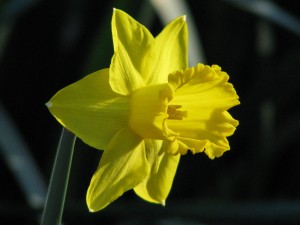
First daffodil, face to the dawn. Mornings find me waking before sunrise, throwing cats off my bed, rousing my elderly dog for her morning ablutions, and scampering down to the hen house in my robe and slippers (and some mornings warm hat and scarf) to feed the hens and the wild ducks, and the tortoise.
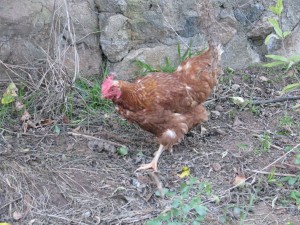
Viola seeing what new seed is available since the night before. Last night when I let Sophie out for her final walk of the night the Santa Ana winds were like a warm caress, riffling through the palm fronds in the dark. Orion sparkled overhead, moving into the position it was in for the birth of both my March babies half a lifetime ago.

Mourning doves in a morning sky. This morning the air was expectant. The garden seemed to emit a trembling energy; an excitement roiling to the surface, but afraid to burst out in full in case of another frost.
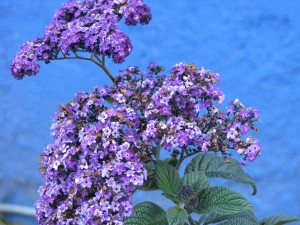
Vanilla-scented heliotrope. Indeed another cold front will be moving in with much-needed rainfall later this week. For now, the bold grasses are up and reckless early stonefruit have blossomed out, much to the joy of the hungry bees.
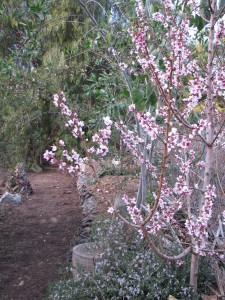
White peach. I could almost hear Browning’s Pippa chanting in my head. But not too much.
The ornamental pear trees all around town are in full glorious bloom. Yesterday while driving from the Community Center to the bookstore there were enough petals strewn in the road as to cause a whirlwind of white as I drove through. An eddy of petals around my car. Joy.
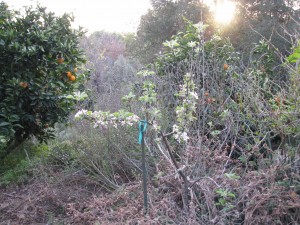
Almond just breaking bud. This weekend is the Great Backyard Bird Count, as well as my two regular bird count days for Project Feederwatch. Before breakfasting I filled seed feeders and enjoyed the show while eating my fresh egg, asparagus, toast and cinnamon tea. Twitterpating is definitely in the air as birds pair up and rival mallards chase each other over the big pond.
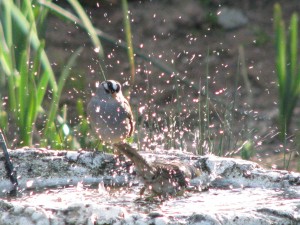
A white crowned sparrow splashing his friend. A Northern mockingbird sips from the bird bath dripper sizing up his territory and listening for new sounds to add to his repertoire. A buzzy rufous hummingbird guards the nectar feeder from the larger and flashier Anna’s. A long-mated pair of crows hang out preening each other on the telephone wire.
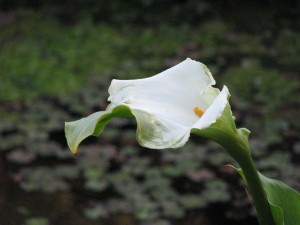
A green-white pond calla. Frogs are croaking amorously in the damp rushes. To my complete joy, far earlier than the bulbs strewn across the property which are just peeking green out of the earth, just outside my window are early daffodils and sweet violets, two of my favorite flowers.
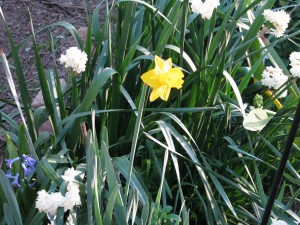
Daffodils, Earlicheer narcissus and a little blue squill. It is still February, and I’m not that great a fan of such a beastly month as February , but for today the paperwork will lie ignored, the cold weather clothes will stay in the laundry basket, and after I take my cat to the vet I will spend the day in the garden (although that isn’t so unusual for me, is it?) listening to the Nuttall’s woodpecker try to drum holes into the telephone pole and smell the scent of Gideon’s trumpet flowers.
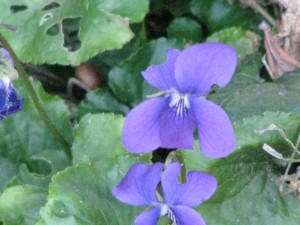
Sweet violets. I look forward to tomorrow when I’ll be making two new friends, and to casting seed which will add new life to the garden.

Easter will be early this year. It is all about possibilities, and possibility is definitely in the air today. I will believe Punxsutawney Phil that although it is technically winter, for today it might as well be spring.
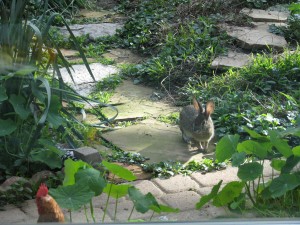
A meeting of the minds. - Animals, Birding, Compost, Gardening adventures, Living structures, Permaculture and Edible Forest Gardening Adventures, Photos, Ponds, Rain Catching
Frost on the Pathways
It doesn’t often frost here in Fallbrook, which is located about an hour from both the mountains and the Pacific in northern San Diego county. When it does, the fruit growers have to take drastic steps to keep their citrus, avocados and other tender plants from dying. The last frost happened after a long steady rain, just after a thick mulch was applied to all the trails here at Finch Frolic Gardens (thank you, Lori!). I awoke to a magical result: just the pathways had turned white with frost. Beautiful! (You can click on the photos to enlarge).
Frost on the newly mulched trail. Between the two ponds. Ice skating rink for birds. Mr. and Mrs. Mallard enjoying some breakfast scratch. Sophie following the trail Little frosty bridge Past the new little bamboo bridge. Strawberries to Frost: “Bring it on!” These wildflowers survive frost just fine. Winter blooms, too! -
The Withy Hide at Ten Months
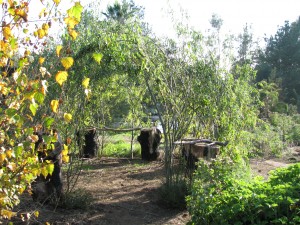
The entrance. Last February I wanted a photography hide and decided to make one out of willow (withy). I cut stalks of curly willow which I already had around the property, stuck them in the ground near the subterranean irrigation lines in a ten-foot diameter, and hoped for the best.

I see a bird! Curly willow tolerates less water, direct sunlight and heat better than the native willows, as well as being delightfully kinky.
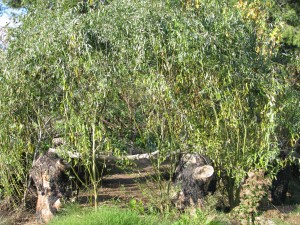
Closer view of the front. The willow grew immediately, gradually sending out tall shoots and lots of leaves. Most withy structures are created with straight willow sticks that are crossed and either tied or woven into a pattern.

A duck’s eye view. Since I began with irregular pieces and the nature of the willow is very curly, I just let it do its thing and figured that abundance would make a good hiding spot. It did.
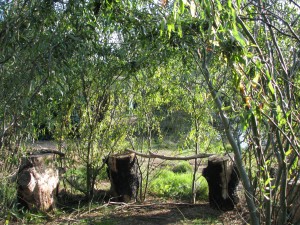
Inside.. A few weeks ago I took some of the tallest stalks and tied them together overhead to create something of a dome shape. I’m not sure how the willow will adapt to the changes, but they ought to begin to grow in that curved shape. I didn’t tie all of them because I wanted a wild look, just semi-tamed.
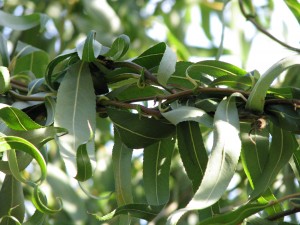
Tying the willow tops together. The willows are already beginning to lose their leaves, creating a wonderful mulch underneath. While the willows are bare there won’t be as good of a hiding spot, but as more stalks grow next year it should fill up beautifully.

Side view. 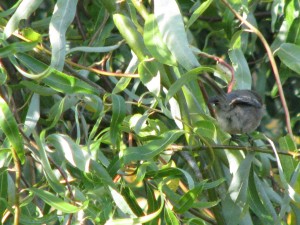
A bird butt. Who is hiding from whom? - Animals, Bees, Birding, Gardening adventures, Other Insects, Permaculture and Edible Forest Gardening Adventures, Ponds, Reptiles and Amphibians, Soil, Worms
Fall Morning
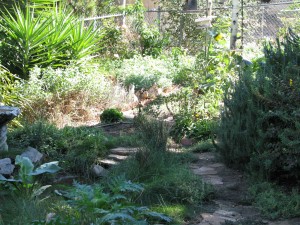
The birdwatching garden. I use the kitchen table as a work center, but spend a lot of time not working. That is because from the big dusty windowseat, through the spiderwebs that catch sunlight in the corners of the glass I watch a fairytale of animals. Song sparrows with their formal stripes and classy single black breast spot hop along the uneven flagstone walkway. The walkway, recently weeded, is again being compromised by sprouts. The small pond wears a heavy scarf of peppermint along its north side, and a mixture of fescues and waterplants around the south. A waterlily bravely floats pads on the still water after having been drastically thinned last month. A calla lily opens partially white, partially green.
Below the window in a dish of seed set low for ground feeders are house finches, the males’ proud red fading like the leaves of the Japanese maple behind the green bench. Lesser goldfinches skeletonize the leaves of sunflowers that have sprouted from birdseed; a nuthatch and a mountain chickadee take turns on the hanging suet feeder, both noisy and reminding me of pine forests. A pair of crows who have lived near this garden for years, but who have been about other business during the summer, are reunited on the telephone line. She grooms his feathers and he leans into her. I’ll have to put treats out for them, to keep on their good side. A Nutall’s woodpecker looks like a childhood toy by hopping straight up the big pine. I grin a welcome to a couple of white crowned sparrows, the forefront of the migratory flock. These spirited and chatty birds shuffle leaves onto my walkway every morning, and I quite happily sweep the leaves back for the next round. It is a ritual just between us. A young scrub jay swoops in with much show, seeing how big a reaction he can get from startling the smaller birds clustering at the feeders or taking warm dirtbaths. He lands on a small trellis and pecks out seeds from a sunflower I propped up after its yellow glory faded. Finches visit when he leaves and take their share of this high protein food.
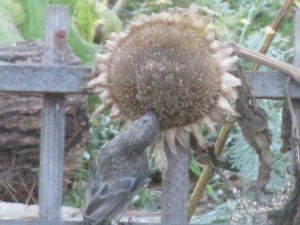
House finch nabbing sunflower seeds ( photo taken through a dirty window! Sorry!) The outside water is turned off; I should be on my knees in mud down by the chicken coop right now fixing a break in the pipe but I am held here by the autumnal light. Even in the morning it slants at a kinder angle, bringing out the gold in the leaves. Later when the water resumes the dripper on the bird bath will start and sparrows, finches, towhees and random visitors will sip drinks and take cleansing baths. One of my favorite sights is watching a group of finches taking turns in the bath, daring each other to stay longer and become wetter. Their splashing sends a cascade of drops into the sunlight. They give Finch Frolic its name. Now the only visitors are honeybees taking water to hydrate their honey. I emphathize with these bees. Only the older females do the pollen gathering, carrying heavy loads in their leg sacks back to the hive until they die in flight. A useful life, but a strenuous and unimaginative one.
Perhaps today there will also be a house sparrow, or a common yellowthroat or a disagreeable California towhee, what everyone knows as a ’round headed brown bird’. Or maybe the mockingbird will revisit the pyracantha berries, staking them out as his territory while finches steal them behind his back. I hear the wrentit’s bouncey-ball call, but as they can throw their voices I usually don’t spot them. Annas hummingbirds spend all their energy guarding the feeders, stopping to peer into the window to see if I’m a threat. My black cat Rosie O’Grady stares back, slowly hunching, mouth twitching with a soft kecking sound as if she could hunt through a window. I see that the hanging tray of grape jelly needs to be taken in and washed because the orioles have all migrated. Rosie is given up by the hummingbird and instead she watches cat TV as the birds shuffle in the Mexican primrose below the window.
I don’t see either of the bunnies this morning, Primrose or Clover. They live under the rosemary bush, and perhaps in the large pile of compost in the corner of the yard. I’ve watched them nibble the invasive Bermuda grass, and pull down stalks of weedy sow thistle and eat the flowers and seeds. They do no harm here, and are helping with the weeding; I love watching them lope around the pathways living in cautious peace.
Unseen by me by where I sit, mosquito fish, aquatic snails, dragonfly larvae, strange worms and small Pacific chorus frogs hang out in the pond and under the overhanging lips of flagstone I placed there just for them. Under the plants are Western fence lizards big and small awaiting warmth from the sun to heat up the rocks so they may climb the highest stone in their territory and posture while the heat quickens their blood. A mouse scurries between plants, capturing bits of birdseed scattered by the messy sparrows. The soil is good here, full of worms and microbes and fungus. Everything is full of life, if you only know how to look for it. You can smell it. You can feel it.
Now comes the spotted towhee, black headed with white patterns on his wings and reddish sides. Once called the rufous-sided towhee, he is bold and handsome, his call a long brash too-weeet. He sassily zig-zags down the narrow flagstone pathway looking for bugs.
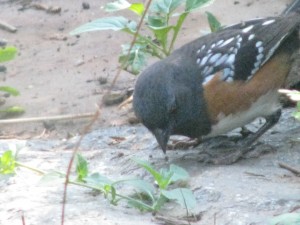
Spotted Towhee grubbing in his fancy clothes, so bright after a molt. I haven’t seen the rat family for a few days. The four youngsters invade the hanging feeders, tossing each other off and being juvenile delinquents. At night I hear the screech of a barn owl, which might be my answer.
The oxblood lilies – always a surprise during the dry and the heat of September, have almost all faded, but sprouts of paper white narcissus are beginning to break ground. They are Fall flowers here, usually done by Thanksgiving.
It is Fall. Finally. The world of my garden is tired and ready for a rest from the heat, the mating, the child rearing, the dryness, the search for diminishing food, the hiding so as not to become food. Although the days here are still in the high 80’s the evenings bring coolness and a much-needed dampness. Rain won’t come until November or later. But we wait for it, the animals, the plants and I. And time passes as I sit at the table and watch. I know of no better way to spend an autumn morning.
-
Keep In Your Pets: It is Predator Season
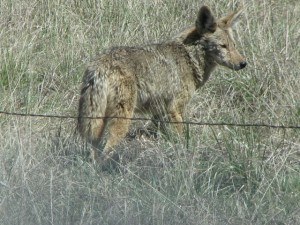
This juvenile coyote was playing with his litter mate at the Santa Rosa Preserve in plain site of the road. Youth just aren’t cautious, no matter what species. Photo by Miranda Kennedy We are entering the time of year when outdoor cats, small dogs, free-range chickens and any small pet go missing. Pre-adult (aka teenage) coyotes from this year’s early litters are just as hungry and just as fearless as human teens, and they are looking to fill growling stomachs during the day and night. (Besides, a study by University of Nebraska found that feral cats are responsible for the extinction of 33 species of birds worldwide. Keep your cats contained!) Can’t blame coyotes because this is their land. Preditors are an important part of our ecosystems and the removal of them have devastating effects on our ecosystems, all the way down to the plants in a process called trophic cascade. During this heat wave I’ve been sleeping with windows open. At about 5:15 am I heard the hens going crazy down in their Fowl Fortress . Throwing on my white robe and slippers I ran down the hill towards the coop. Just before I reached it, a young handsome coyote came around the corner behind the compost bins and we nearly collided. He was across the property and over the chain link fence in a heartbeat. The hens were safe because the Fortress is wired up both sides and across the top, and the wire goes into the dirt. However if the coyote were to have time to dig he could have been inside. The hens were so upset that they didn’t lay right for several days. Miss Amelia, the leader, was on top of the chicken tractor screeching away. Chickpea and even formidably-built Lark were on top of the smaller coop. These three survived the coyote attack that killed two of their friends last winter (pre-Fowl Fortress). The two adopted Rhode Island Reds were standing by the door wondering what all the fuss was about; they’ve seen our two elderly, partially deaf and blind dogs walk past all the time. General Mischief, whose probably only working park is his sniffer, lumbered excitedly around the property following the coyote’s path. At night I began to lock the hens inside the chicken tractor where they roost inside the Fortress, so that they’d have two lines of defense.
The next morning I arose to chicken screeching even earlier, and ran down there to see a coyote coming from around the back of the Fortress. I knew where it would jump the fence so I ran in that direction, which gave it quite a surprise as it had to pass me to get there. I stood at the fenceline brandishing a rake that I had caught up on the way down the hill, dressed in slippers and long white robe, shouting threats into the neighbor’s backyard like a lunitic. One thing about growing older is that eccentric behavior is excused.
I wasn’t about to let the coyotes believe they could hunt within my fence. The next morning I was up and out just after five, me and General, my rake and my white robe, over which I’d pulled a red jacket because the morning was misty. I stood at the fenceline, pulling some ragweed to not waste time. In about five minutes I felt that they were coming and stood waiting. Sure enough, halfway across the neighbor’s property were some bushes and from around behind them trotted a coyote. He looked pretty jaunty and sure of himself until he turned and caught an eyeful of me. I shook my rake and he seemed to shake his head disbelievingly. Then he cut out the way he had come. Victory for me!
I collected dog poo and dumped it along the fenceline, and stuck clumps of fur left from shaving General’s thick coat into the top holes in the fence. I love the country life.
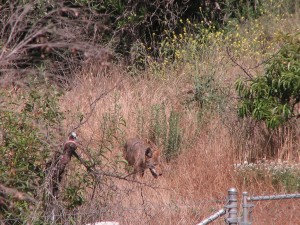
Of course I didn’t bring a camera on my morning patrols. This coyote was in what is now the Bee Garden, several years ago. He looks worse for wear. Photo by Miranda Kennedy. For the next few mornings I’d roll out of bed, motivate Sophie and General to get up and go outside, and I’d patrol the fence and make my presence known at the entry point. Although I was sleep-deprived (with the late darkness I tend to only get dinner at about 9 and to bed by 11) I managed to to get some impressive gardening done, especially since I changed into old clothes before heading out. There was no more coyote activity, at least none that the hens told me about.
The other night the pack was running down in the streambed and were yipping and howling in communication. I think it was just past midnight, but I went out there just to make sure there were no visitors.
Sophie is a 14 year old rescued pit bull mix I’ve had since she was about a year old. I knew that she had run with coyotes as a youngster when her owner let her loose, and I never understood why she hadn’t been attacked. Her back legs don’t work well, and she’s feeling her age. She used to climb the chain link fence and roam the neighborhood. She used to kill cats, chase rabbits, keep the mice and rats out of the garage where they used to sleep. For the last few years it has been all peace and love with Sophie. She not only seems to be afraid of some of the cats in the house, but would walk past the ranging hens without putting any of her thoughts into action. I once went to wake her up when she was still sleeping outside, and a mouse ran out from under her. I’d disturbed its warm cozy sleep.
So this morning I let out the dogs when General woke me up and tried to go back to bed. It never works because when General is done he rakes the metal security door with his nails until I let him in again. Sure enough, in about five minutes he was demanding attention again so I put on my robe and went out to do the hens. I was just past the driveway when I caught sight of Sophie on one of the garden paths close to the house. She had a friend with her. A coyote. Sophie was just turning away from it to walk back to the house and the coyote was looking around at the bushes, hopeful for a rabbit breakfast until it saw me and scooted away. The fur was raised a little on Sophie’s back, but not all the way. I made sure he was clear of the property, and checked the hens who were still double locked in. Then I had a few words with Sophie about the choice of friends she asked over!
-
Melting Birds
Perhaps you’ve noticed birds doing strange things. I certainly have. Often they glance around afterwards to see if anyone is watching. One very silly-looking thing birds do is sun themselves. They will spread their wings to catch the most warmth, then go into kind of a trance.

Western Bluebird They’ll put their heads to the side and simply melt in the sun. Often I’ve wondered about the safety of their balance.

High wire act But they always seem to come out of it okay. I’ve seen many different kinds of birds melting in the warmth, taking a sun bath. Usually it makes me want to do the same.

Western Bluebird against heat-reflecting fence.
